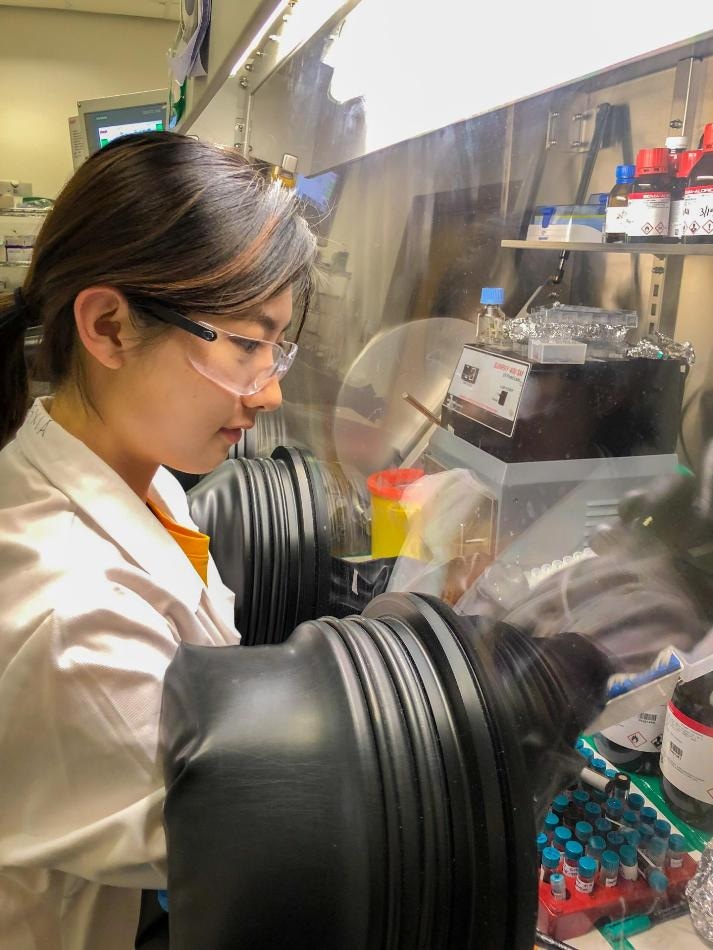May 23 2019
Engineering researchers at the University of Toronto have integrated two evolving technologies for sophisticated solar power—and found that each one aids in stabilizing the other.
 Mengxia Liu (ECE PhD 1T8) is the lead author on a new paper in Nature that describes a way to combine two promising solar technologies—perovskites and quantum dots—in order to enhance their stability. (Image credit: Sanyang Han)
Mengxia Liu (ECE PhD 1T8) is the lead author on a new paper in Nature that describes a way to combine two promising solar technologies—perovskites and quantum dots—in order to enhance their stability. (Image credit: Sanyang Han)
The hybrid material, thus obtained, represents an important breakthrough towards cutting down the cost of solar power and, at the same time, multiplying the ways it can be utilized.
Currently, almost all solar cells are fabricated from high-purity silicon. This technology is well established and, in the recent past, the cost associated with the development of silicon-based solar cells has reduced considerably owing to economies of scale. However, silicon has also an upper limit to its efficiency.
Headed by Professor Ted Sargent (ECE), a research team is now looking for complementary materials that can improve the silicon’s solar-harvesting potential by absorbing light wavelengths that otherwise cannot be done by silicon.
Two of the technologies we pursue in our lab are perovskite crystals and quantum dots. Both of these are amenable to solution processing. Imagine a ‘solar ink’ that could be printed onto flexible plastic to create low-cost, bendable solar cells. We can also combine them in front of, or behind, silicon solar cells to further enhance their efficiency.
Ted Sargent, Professor, Electrical & Computer Engineering, University of Toronto
Stability is one of the main difficulties facing both quantum dots and perovskites. At room temperature, certain forms of perovskites go through a modification in their 3D crystal structure that makes them transparent—that is, they are no longer able to absorb solar radiation completely.
Quantum dots, for their part, should be enclosed in a thin layer called a passivation layer. This layer, measuring just one molecule thick, inhibits the quantum dots from adhering to one another; however, the passivation layer can be destroyed if the temperatures are above 100 ºC, making the quantum dots to clump or aggregate together, destroying their potential to harvest light.
In a paper recently reported in the Nature journal, a research team from Sargent’s laboratory demonstrated a method to integrate quantum dots and perovskites that stabilizes both.
Before we did this, people usually tried to address the two challenges separately. Research has shown the successful growth of hybrid structures that incorporated both perovskites and quantum dots. This inspired us to consider the possibility that the two materials could stabilize each other if they share the same crystal structure.
Mengxia Liu, Study Lead Author and Postdoctoral Fellow, Cambridge University
Two types of hybrid materials were developed by Liu and the team. One material was mainly quantum dots with roughly 15% perovskites by volume, and is specifically made to convert light into electricity, while the other was chiefly perovskites with below 15% quantum dots by volume, and is more suitable for converting electricity into light, for instance, as part of a light emitting diode, or LED.
The researchers were able to demonstrate that the perovskite-based material continued to remain steady under ambient conditions (30% humidity and 25 ºC) for a period of six months, approximately 10 times longer compared to materials made up of the same perovskite alone. When the quantum dot material was heated to 100 ºC, the nanoparticle aggregation was five times lower than if they had not been stabilized with perovskite materials.
“It proved out our hypothesis remarkably well,” stated Liu. “It was an impressive outcome beyond our expectations.”
The latest paper offers proof-of-concept for the theory that hybrid materials like these can improve stability. In the coming days, Liu believes that manufacturers of solar cells will take her concepts and further work on them to design solution-processed solar cells that fulfill all the same criteria as conventional silicon-based equivalents.
Industrial researchers could experiment by using different chemical elements to form the perovskites or quantum dots. What we have shown is that this is a promising strategy for improving stability in these kinds of structures.
Mengxia Liu, Study Lead Author and Postdoctoral Fellow, Cambridge University
“Perovskites have shown tremendous potential as solar materials, but fundamental solutions are needed to turn them into stable and robust materials that can meet the demanding requirements of the renewable energy sector,” stated Jeffrey C. Grossman, the Morton and Claire Goulder and Family Professor in Environmental Systems and a Professor in the Department of Materials Science and Engineering at the Massachusetts Institute of Technology, who was not part of the study. “The Toronto study shows one exciting new avenue to advancing the understanding, and the achievement, of stable perovskite crystal phases.”
Liu partly credits the discovery to the collaborative environment in the group, which included scientists from various disciplines, including physics, chemistry, and her own domain of materials science.
“Perovskite and quantum dots have distinct physical structures, and the similarities between these materials have been usually overlooked,” she stated. “This discovery shows what can happen when we combine ideas from different fields.”